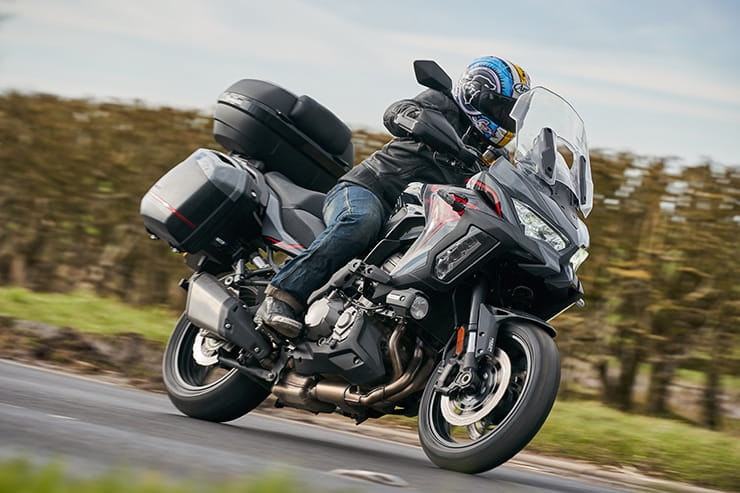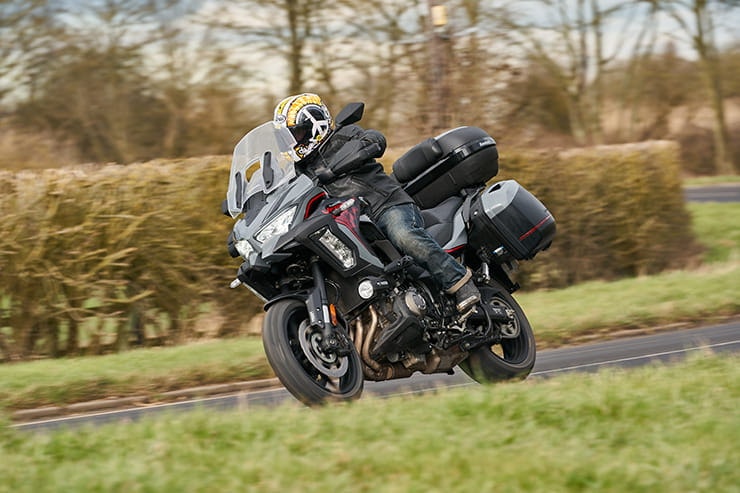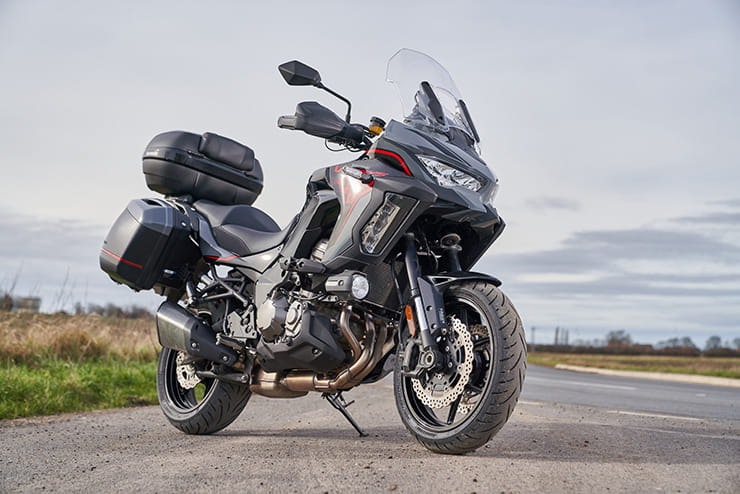Kawasaki Versys 1000 S Grand Tourer (2021) - Review
BikeSocial Road Tester
02.03.2021
For 2021 Kawasaki has removed the base-model Versys 1000 from their line-up and replaced it with the high-spec Kawasaki 1000 S, which features all the sophistication of the SE model, but with manually-adjustable, conventional Showa suspension, rather than the Showa Skyhook system as on the SE. On test we have the fully-loaded Grand Tourer edition, complete with top box (47l), panniers (56l), tank pad, GPS bracket, fog lights, and frame sliders.
I was lucky enough to attend the world launch of Kawasaki’s big Versys in 2012, and although it was hardly love at first sight, its qualities soon came to my attention – especially the way the adventure-styled tourer churned out big miles smoothly while cosseting both rider and pillion. Since then, the qualities of the original have been improved and refined, while Kawasaki have also tried to make the Versys more visually appealing because, let’s be honest, the original bike could only be loved by its mother.
The original bike’s DNA is firmly rooted, meaning little off-road capability and a clear focus on high-mileage road riding. While other manufacturers try 19-inch or even 21-inch front wheels in pursuit of off-road performance, Kawasaki has kept things relatively simple with 17-inch rims front and rear plus long-travel suspension.
As we move into 2021, Kawasaki has introduced a new model, the 1000 S. In fact, there are three different models to choose from because the S model is available in three options: Versys 1000 S (£12,999), Versys 1000 S Tourer (£13,799), and the Versys 1000 S Grand Tourer (£14,699), which is the version we have our hands on here.
Essentially what Kawasaki has done is remove the base model, which was a bargain in today’s market (£11,300), and introduce a new model, the S version which is closer to the full spec SE model which comes with semi-active Showa suspension (£14,899). The S version features the high level of spec of the SE, but with standard conventional, manually adjustable suspension. We spent 700 miles with the S version to see if it’s worth the extra dollar.
Smooth engine
Comfortable solo and two up
High level of spec for the price
View on board, clocks
Brakes are lacking compared to the competition
Physical dimensions and heavy
Above: fully loaded GT spec
Kawasaki Versys 1000 S Price - £12,999 (Grand Tourer £14,699)
The 2020 Versys was a tempting £11,300 and now the standard 1000 S model is £12,999 which is a significant price hike of £1699. But for the extra bucks you do get a lot more spec, including smartphone connectivity, multiple riding modes linked to rider aids (there were only two previously, and not linked), LED corning headlights, an adjustable screen, up and down quick-shifter, heated grips, and 12v power socket – oh, and not forgetting the ‘self-healing paint’. That is a lot of kit for the money, while £13,000 is a relatively modest asking price when you compare the standard S to the competition.
A base BMW R1250GS or S1000 XR, is around £14,000, before any must-add extras. For a similar spec to the Kawasaki, you are going to have to spend north of £16,000 if you want a BMW badge on the side. Ducati’s new Multistrada V4 is £15,495, but for a similar spec to the Kawasaki you are going to have to opt for the S model at £18,395. Ok, I hear your argument, the Ducati is far more desirable, has more tech, like radar detection, and both pre-mentioned BMWs have more power, torque and cache, plus less weight… but are they worth £3000 more than the Versys?
On test, we have the Grand Tourer (£14,699), which is a lot of bike for the price. It comes with a top box (47l), panniers (56l), tank pad, GPS bracket, fog lights, and frame sliders. The luggage has high-quality internal bags and is accessible via the same key and matches the lines and colours of the bike. Under 15k for a brand new and fully equipped tourer? Relatively speaking, that’s not bad.
Power and torque
Back in 2012 when the original Versys was launched, the Z1000 based motor produced an impressive 116bhp. In 2015 we went up a few bhp to 118bhp, which remains the same today. Now, 118bhp may not impress your mates at the café – it’s not headline-grabbing like the Ducati Multistrada V4 with its 168 racing Italian horses – but how much do you need?
Peak power is 118bhp @ 9000rpm, whilst peak torque is 102Nm @ 7500rpm. Again, this is far from class-topping performance, but over 100Nm and close to 120bhp isn’t bad for a 1044cc inline four-cylinder engine.
Above: Dull clocks, plenty of switches to keep you busy, and the GT spec luggage
Engine, gearbox and exhaust
Kawasaki’s new Versys 1000 S is like an England rugby prop - surprisingly fast when it gets going - and this big ’un can certainly run. Power is smooth and effortless and riding the Kawa is like surfing towards the beach on a huge wave. It doesn’t feel quick because it’s relaxed, the wind protection is excellent, and you’re not accompanied by a wailing or tiring exhaust tone. Then you look down at the large speedo and soon realise you’re approaching, er 70mph, yes definitely 70, without realising it. The Versys is all about refined and understated speed.
There is a large analogue rev-counter on the left side of the relatively dull but easy-to-read instrumentation, and when you approach the redline the bold/large gear indicator starts to flash. I brushed the rev limit a few times as I was simply riding the Versys incorrectly. I’d jumped onto it from a rev-happy sports bike but soon realised there’s no need to rev the Versys, only to short shift on the smooth quick-shifter and change gear well before peak torque at 7500rpm… and enjoy the magic carpet sensation of power.
The weight of the S is a quoted 255kg. Add a rider plus pillion and load up the luggage, and kilos begin to build seriously towards 400kg, but there’s enough power to make the ride spirited enough (but I’m unsure why the rev counter reads to 14,000rpm when the redline is at 10,000rpm?). There’s enough torque to make overtakes safe and quick. But when fully loaded it sometimes takes a tap-back of one gear on the clutchless quick-shifter just to make sure. I never felt as if I wanted more power. But would that change fully loaded, on the autobahn in Germany, or climbing through the passes in the Alps? When compared to similar but more expensive bikes in this class there is no hiding the fact it is down on power.
While we’re discussing the new standard quick-shifter, I found upshifts to be smooth and effortless, but backshifts weren’t as smooth, especially at slow speeds and low rpm.
There are three riding modes to choose from, plus one riding mode which allows you to customise the settings. I spent 90% of the test in the Road mode, which means full power and a smooth throttle response, with the lean-sensitive rider aids active. Sport mode doesn’t give a jump in power or torque, it just appears to reduce the refinement, which is why I stayed in the Road mode for the majority of the time.
Kawasaki Versys 1000 S Comfort and economy
This is where the big Versys scores highly. It is brilliantly comfortable. I completed 170 miles in one stint (until the fuel light came on) without any complaints. I could have filled up and done another 170 miles straightway. This is a bike that will take on a 500-mile-plus day with consummate ease. Fast cruising or touring is effortless. Flick up into top gear, set the cruise control to 80-90mph depending on which country you are in, sit back and enjoy. The adjustable screen is huge and deflects all the windblast. The handguards aren’t bad and now you have the added luxury of three-stage heated grips – the only downside is there’s no illustration on the dash to show they are on or at which level.
The Versys’ adventure bike ergonomics are spot on, and the seat is wide and comfortable, even for the pillion. There is also a bit of extra padding on the top box for the pillion to rest against. The clocks may miss the iPad bling of some of the competition, but they are simple and easy to read, and the switchgear is intuitive. With the ride and suspension on the soft side, the uprated Versys experience is, overall, very smooth – a breeze.
At night, the lean-sensitive cornering headlights work impressively and the extra fog lights give a clear view ahead, though it’s a shame the switch is hard to reach and appears to be an afterthought. With the now standard heated grips to the max, the screen fully upright offering excellent wind protection, it was a pleasure to ride at night, despite low temperatures.
Just over 50mpg is impressive, too, especially when you take into consideration the bulk and weight of the bike. We tested the fully loaded Grand Tourer, and I’m sure the standard S model without luggage would be more frugal. 21 litres of petrol equates to a theoretical range of 280 miles, though in the real world the low-fuel light came on at 160-170 miles after some fast motorway miles (with around 30-40 miles remaining). Certainly, 200 miles between fill-ups is possible depending on the conditions and the weight of the bike.
Handling, suspension and weight
The new Versys S rides on conventional Showa suspension, with pre-load and rebound damping adjustment on the front (right leg only) and the same on the rear (along with a remote, easy-access pre-load adjuster) as opposed to semi-active Showa Sky Hook suspension on the top-level SE. The suspension has been designed for comfort and ride quality rather than performance but, like the engine, the chassis can take you by surprise. It takes a little effort, but it can hustle.
There is no hiding the fact that this is a big and heavy bike, one that you can’t flick to foot-peg scraping levels of lean with ease. But once you understand this, and ride to the bike's strengths, it can be rewarding. Ride smoothly, carry momentum, and the Kawasaki will deliver. It’s a little like going back a few years: brake on the approach, off the brakes, roll in, feel the grip, and accelerate out. However, unlike days of old, when you get it wrong, you have excellent electronic aids helping you out.
The lean-sensitive traction control is excellent; I could feel it working when the tyre was cold and controlling the front wheel lift when I pushed a little too hard in the first two gears.
If you’re coming from a sports bike or a sporty naked machine and are used to diving into the apex on the brakes, and holding a tight line, then you might be disappointed by the standard set up on the Kawasaki. It’s on the soft side, and the rear does benefit from some added pre-load, especially when loaded. On a few occasions, I drifted wide on the exit, and it will understeer if you ask too much of the handling.
If, on the other hand, you are coming to the Versys from a tourer then the electronic aids are excellent, and in the dry, once you’ve clicked into the ‘old-school’ way of riding, you can have some peg scraping fun on the big Versys. Just be aware that it is far more touring than sports.
Kawasaki Versys 1000 S Brakes
Modern brakes are exceptional, with massive stopping power even on ‘entry level’ bikes and race-inspired radial Brembo stoppers now common on tourers, but the Kawasaki’s aren’t quite up there with the best. The ABS is not too intrusive on the road and, while the front 310mm petal discs and calipers have a nice feel, you will need all four fingers when coming down from fast dual-carriage way speeds to slow roundabouts. Again, it depends on what you are used to – this is not one-finger race bike braking – and the competition from BMW, KTM, and Ducati all have race-spec brakes (and also weigh less than the Kawasaki).
Rider aids, extra equipment and accessories
The 1000 S comes with three integrated riding modes, which change the power characteristics and rider aid intervention. These are Rain, Road and Sport. There is also a fourth mode, called Rider, which enables you to personalise your own settings, full power and no traction, for example. ABS can’t be deactivated. Previously the modes didn’t change the rider aids, and there were only two to choose from. The traction control (KTRC) has three settings and can be switched off. The rider aids are all linked to the Kawasaki Cornering Management Function (KCMF), which is essentially a Bosch IMU and means both the ABS and traction control are lean-sensitive.
The system is clear and easy to understand, and simple enough to change on the move via the modes. On some models in this class the rider aids are almost too much, but on the Kawasaki they are much easier to comprehend, and you don’t need to be an IT consultant to work them out. The TC works well, is relatively smooth and the reintervention is smooth, relatively slow and reassuring.
The Grand Tourer comes fully loaded with everything you need: top box (47l), panniers (56l) with inner bags, tank pad, GPS bracket, fog lights and frame sliders. The top box and panniers are neat, easy to access and remove. You could add extras like the Akrapovič black end can, and there is an optional lower seat, which reduces the seat height by 20mm. But that is about it, the Grand Tourer is fully equipped for a few weeks touring – ready to go for under £15k.
Rivals
From tourers to adventures bikes and everything in between that claims to do both well, there are plenty of options to research if a Versys 1000 is on your wish list. The Multistrada 950 would be a close competitor as would the Suzuki V-Strom 1000 or Triumph Tiger 900 and they could have easily slotted into this table:
Kawasaki Versys 1000 S Verdict
I’ve always had a soft spot for Kawasaki’s Versys. It was the ugly duckling of their range when it was launched and has never been their star player, but it is consistently underestimated and has always offered value for money. Kawasaki have hiked the price for 2021 but, equally, they have improved the spec in direct proportion, and the base model is still under £13k, considerably less than the competition. There are niggles: it is a heavy bike; the clocks - although clear - lack some bling; the handling is far more touring than sports; and, personally, I’d want stronger brakes. In some areas, like power, it is just behind the competition. However, it excels in comfort, especially for larger riders who regularly carry a pillion, and the level of spec is impressive for the price. The new 1000 S continues the original bike's good work, meaning it is still value for money, still smooth and comfortable, but now with more extras to make it more appealing than ever. Is there a better way to travel across Europe for £13,000 or £14,499? I don’t think so. If you’re not worried about razor-sharp handling, and don’t need 150bhp plus, then the Kawasaki might be for you.
Kawasaki Versys 1000 S Technical Specification
Photography by Joe Dick
What is MCIA Secured?
MCIA Secured gives bike buyers the chance to see just how much work a manufacturer has put into making their new investment as resistant to theft as possible.
As we all know, the more security you use, the less chance there is of your bike being stolen. In fact, based on research by Bennetts, using a disc lock makes your machine three times less likely to be stolen, while heavy duty kit can make it less likely to be stolen than a car. For reviews of the best security products, click here.
MCIA Secured gives motorcycles a rating out of five stars, based on the following being fitted to a new bike as standard:
A steering lock that meets the UNECE 62 standard
An ignition immobiliser system
A vehicle marking system
An alarm system
A vehicle tracking system with subscription
The higher the star rating, the better the security, so always ask your dealer what rating your bike has, and compare it to other machines on your shortlist.


